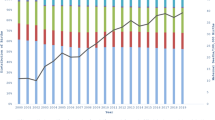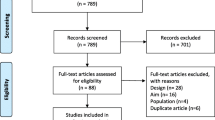Abstract
Objectives We sought to examine whether there are systematic differences in ascertainment of preexisting maternal medical conditions and pregnancy complications from three common data sources used in epidemiologic research. Methods Diabetes mellitus, chronic hypertension, gestational diabetes mellitus (GDM), gestational hypertensive disorders (GHD), placental abruption and premature rupture of membranes (PROM) among 4821 pregnancies were identified via birth certificates, maternal self-report at approximately 4 months postpartum and by discharge codes from the Statewide Planning and Research Cooperative System (SPARCS), a mandatory New York State hospital reporting system. The kappa statistic (k) was estimated to ascertain beyond chance agreement of outcomes between birth certificates with either maternal self-report or SPARCS. Results GHD was under-ascertained on birth certificates (5.7 %) and more frequently indicated by maternal report (11 %) and discharge data (8.2 %). PROM was indicated more on birth certificates (7.4 %) than maternal report (4.5 %) or discharge data (5.7 %). Confirmation across data sources for some outcomes varied by maternal age, race/ethnicity, prenatal care utilization, preterm delivery, parity, mode of delivery, infant sex, use of infertility treatment and for multiple births. Agreement between maternal report and discharge data with birth certificates was generally poor (kappa < 0.4) to moderate (0.4 ≤ kappa < 0.75) but was excellent between discharge data and birth certificates for GDM among women who underwent infertility treatment (kappa = 0.79, 95 % CI 0.74, 0.85). Conclusions for Practice Prevalence and agreement of conditions varied across sources. Condition-specific variations in reporting should be considered when designing studies that investigate associations between preexisting maternal medical and pregnancy-related conditions with health outcomes over the life-course.

Similar content being viewed by others
References
Alexander, G. R., & Kotelchuck, M. (2001). Assessing the role and effectiveness of prenatal care: History, challenges, and directions for future research. Public Health Reports (Washington, D. C.: 1974), 116(4), 306–316.
Ananth, C. V. (2005). Perinatal epidemiologic research with vital statistics data: Validity is the essential quality. American Journal of Obstetrics and Gynecology, 193(1), 5–6.
Bat-Erdene, U., Metcalfe, A., McDonald, S. W., & Tough, S. C. (2013). Validation of canadian mothers’ recall of events in labour and delivery with electronic health records. BMC Pregnancy and Childbirth, 13(suppl 1), S3.
Brown, M. C., Best, K. E., Pearce, M. S., Waugh, J., Robson, S. C., & Bell, R. (2013). Cardiovascular disease risk in women with pre-eclampsia: Systematic review and meta-analysis. European Journal of Epidemiology, 28(1), 1–19.
Buck Louis, G. M., Hediger, M. L., Bell, E. M., Kus, C. A., Sundaram, R., McLain, A. C., Yeung, E., Hills, E. A., Thoma, M. E., & Druschel, C. M. (2014). Methodology for establishing a population-based birth cohort focusing on couple fertility and children’s development, the Upstate KIDS Study. Paediatric and Perinatal Epidemiology, 28(3), 191–202.
Buck Louis, G. M., Druschel, C., Bell, E., Stern, J. E., Luke, B., McLain, A., Sundaram, R., & Yeung, E. (2015). Use of assisted reproductive technology treatment as reported by mothers in comparison with registry data: The Upstate KIDS study. Fertility and Sterility, 103(6), 1461–1468.
Buka, S. L, Goldstein, J. M, Spartos, E, Tsuang, M. T. (2004). The retrospective measurement of prenatal and perinatal events: Accuracy of maternal recall. Schizophrenia Research, 71(2–3):417–26.
Campbell, K. H., Savitz, D., Werner, E. F., Pettker, C. M., Goffman, D., Chazotte, C., & Lipkind, H. S. (2013). Maternal morbidity and risk of death at delivery hospitalization. Obstetrics and Gynecology, 122(3), 627–633.
Cohen, B., Bernson, D., Sappenfield, W., Kirby, R. S., Kissin, D., Zhang, Y., Copeland, G., Zhang, Z., & Macaluso, M. (2014). Accuracy of assisted reproductive technology information on birth certificates: Florida and Massachusetts, 2004–06. Paediatric and Perinatal Epidemiology, 28(3), 181–190.
Coolman, M., de Groot, C. J., Jaddoe, V. W., Hofman, A., Raat, H., & Steegers, E. A. (2010). Medical record validation of maternally reported history of preeclampsia. Journal of Clinical Epidemiology, 63(8), 932–937.
DiGiuseppe, D. L., Aron, D. C., Ranbom, L., Harper, D. L., & Rosenthal, G. E. (2002). Reliability of birth certificate data: A multi-hospital comparison to medical records information. Maternal and Child Health Journal, 6(3), 169–179.
Gong, J., Savitz, D. A., Stein, C. R., & Engel, S. M. (2012). Maternal ethnicity and pre-eclampsia in New York city, 1995–2003. Paediatric and Perinatal Epidemiology, 26(1), 45–52.
Greenland, S. (1996 ). Basic methods for sensitivity analysis of biases. International Journal of Epidemiology, 25(6), 1107–1116.
Katki, H. A., & Edelstein, D. W. (2011). Compare tests: Estimating agreement and diagnostic accuracy when one test is not conducted on all specimens. r package version 1 0 Available from http://dceg.cancer.gov/bb/tools/CompareTests.
Katki, H. A., Li, Y., Edelstein, D. W., & Castle, P. E. (2012). Estimating the agreement and diagnostic accuracy of two diagnostic tests when one test is conducted on only a subsample of specimens. Statistics in Medicine, 31(5), 436–448.
Kirby, R. S. (2001). Invited commentary: Using vital statistics databases for perinatal epidemiology: does the quality go in before the name goes on? American Journal of Epidemiology, 154(10), 889–890.
Lain, S. J., Hadfield, R. M., Raynes-Greenow, C. H., Ford, J. B., Mealing, N. M., Algert, C. S., & Roberts, C. L. (2012). Quality of data in perinatal population health databases: A systematic review. Medical Care, 50(4), e7–e20.
Lydon-Rochelle, M. T., Holt, V. L., Cardenas, V., Nelson, J. C., Easterling, T. R., Gardella, C., & Callaghan, W. M. (2005). The reporting of pre-existing maternal medical conditions and complications of pregnancy on birth certificates and in hospital discharge data. American Journal of Obstetrics and Gynecology, 193(1), 125–134.
Malcolm, J. (2012). Through the looking glass: Gestational diabetes as a predictor of maternal and offspring long-term health. Diabetes/Metabolism Research and Reviews, 28(4), 307–311.
Northam, S., & Knapp, T. R. (2006). The reliability and validity of birth certificates. Journal of Obstetric, Gynecologic, and Neonatal Nursing: JOGNN/NAACOG, 35(1), 3–12.
Ray, J. G., Burrows, R. F., Burrows, E. A., & Vermeulen, M. J. (2001). MOS HIP: McMaster outcome study of hypertension in pregnancy. Early Human Development, 64(2), 129–143.
Reichman, N. E., & Hade, E. M. (2001). Validation of birth certificate data. A study of women in New Jersey’s healthstart program. Annals of Epidemiology, 11(3), 186–193.
Rice, F., Lewis, A., Harold, G., van den, B. M., Boivin, J., Hay, D. F., Owen, M. J., & Thapar, A. (2007). Agreement between maternal report and antenatal records for a range of pre and peri-natal factors: The influence of maternal and child characteristics. Early Human Development, 83(8), 497–504.
Roberts, C. L., Bell, J. C., Ford, J. B., Hadfield, R. M., Algert, C. S., & Morris, J. M. (2008). The accuracy of reporting of the hypertensive disorders of pregnancy in population health data. Hypertension in Pregnancy: Official Journal of the International Society for the Study of Hypertension in Pregnancy, 27(3), 285–297.
Roohan, P. J., Josberger, R. E., Acar, J., Dabir, P., Feder, H. M., & Gagliano, P. J. (2003). Validation of birth certificate data in New York state. Journal of Community Health, 28(5), 335–346.
Savitz, D. A., Janevic, T. M., Engel, S. M., Kaufman, J. S., & Herring, A. H. (2008). Ethnicity and gestational diabetes in New York city, 1995–2003. BJOG: An International Journal of Obstetrics and Gynaecology, 115(8), 969–978.
Sterne, J. A., White, I. R., Carlin, J. B., Spratt, M., Royston, P., Kenward, M. G., Wood, A. M., & Carpenter, J. R. (2009). Multiple imputation for missing data in epidemiological and clinical research: Potential and Pitfalls. BMJ (Clinical Research ed.), 338, b2393.
Stuart, J. J., Bairey Merz, C. N., Berga, S. L., Miller, V. M., Ouyang, P., Shufelt, C. L., Steiner, M., Wenger, N. K., & Rich-Edwards, J. W. (2013). Maternal recall of hypertensive disorders in pregnancy: A systematic review. Journal of Women’s Health (2002), 22(1), 37–47.
Szklo, M., & Nieto, J. F. Epidemiology: beyond the basics. Jones & Bartlett Publishers, 4 A.D.
Troude, P., L’Helias, L. F., Raison-Boulley, A. M., Castel, C., Pichon, C., Bouyer, J., & de La, R. E. (2008). Perinatal factors reported by mothers: Do they agree with medical records?. European Journal of Epidemiology, 23(8), 557–564.
Vinikoor, L. C., Messer, L. C., Laraia, B. A., & Kaufman, J. S. (2010). Reliability of variables on the North Carolina birth certificate: A comparison with directly queried values from a cohort study. Paediatric and Perinatal Epidemiology, 24(1), 102–112.
von, E. E., Altman, D. G., Egger, M., Pocock, S. J., Gotzsche, P. C., & Vandenbroucke, J. P. (2008). The strengthening the reporting of observational studies in epidemiology (STROBE) statement: Guidelines for reporting observational studies. Journal of Clinical Epidemiology, 61(4), 344–349.
Wang, Y., Caggana, M., Sango-Jordan, M., Sun, M., & Druschel, C. M. (2011). Long-term follow-up of children with confirmed newborn screening disorders using record linkage. Genetics in Medicine: Official Journal of the American College of Medical Genetics, 13(10), 881–886.
Woodward, M. (2014). Epidemiology: study design and data analysis. Boca Raton, FL, Taylor and Francis Group, LLC.
Yasmeen, S., Romano, P. S., Schembri, M. E., Keyzer, J. M., & Gilbert, W. M. (2006). Accuracy of obstetric diagnoses and procedures in hospital discharge data. American Journal of Obstetrics and Gynecology, 194(4), 992–1001.
Yeung, E., Robledo, C., Boghossian, N., Zhang, C., & Mendola, P. (2014). Developmental origins of cardiovascular disease. Current Epidemiology Reports, 1, 9–16.
Zollinger, T. W., Przybylski, M. J., & Gamache, R. E. (2006). Reliability of Indiana birth certificate data compared to medical records. Annals of Epidemiology, 16(1), 1–10.
Acknowledgments
This work was supported by the Intramural Research Program of the Eunice Kennedy Shriver National Institute of Child Health and Human Development (NICHD; contracts #HHSN275201200005C, #HHSN267200700019C). We also would like to acknowledge and thank the Upstate KIDS families and staff for their important contributions.
Author information
Authors and Affiliations
Corresponding author
Ethics declarations
Conflict of Interest
The authors declare no conflict of interest.
Electronic supplementary material
Below is the link to the electronic supplementary material.
Rights and permissions
About this article
Cite this article
Robledo, C.A., Yeung, E.H., Mendola, P. et al. Examining the Prevalence Rates of Preexisting Maternal Medical Conditions and Pregnancy Complications by Source: Evidence to Inform Maternal and Child Research. Matern Child Health J 21, 852–862 (2017). https://doi.org/10.1007/s10995-016-2177-8
Published:
Issue Date:
DOI: https://doi.org/10.1007/s10995-016-2177-8




